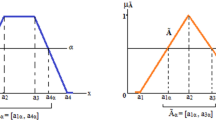Abstract
Manufacturing organizations often make complex decisions in regards to investment in new manufacturing technologies (NMT). These NMT are assessed based on attributes such as flexibility, quality etc., which are hard to quantify. This fact calls upon the need for a structured decision support systems that can adequately represent qualitative and subjective assessments. The gist of this paper is to propose an integrated fuzzy analytic hierarchy process (AHP) based approach to facilitate the selection and evaluation of NMT in the presence of intangible attributes and uncertainty. Three important issues that are pertinent and critical to fuzzy AHP, namely contradiction in user preferences, deriving priorities from inconsistent fuzzy judgment matrices, and group decision-making are addressed in detail. Also, an attempt is made to compare fuzzy preference programming (FPP) and two-stage logarithmic goal programming (TLGP) based fuzzy prioritization methods. Based on the comparative study, it is concluded that FPP is preferred over TLGP to select and evaluate NMT. Numerical examples are provided to illustrate the aforementioned issues.
Similar content being viewed by others
References
Triantaphyllou E (2000) Multi-criteria decision making methods: A comparitive study. Kluwer, Drodrecht
Vaidya OS, Kumar S (2004) Analytic hierarchy process: An overview of application. Eur J Opr Res DOI 10. 1016/j.ejor.2004.04.28
Wabalickis RN (1988) Justification of FMS with the analytic hierarchy process. Manf Sys 17:175−182
Datta VK, Samabasivarao V, Kodali R, Deshmukh SG (1992) Multi-attribute decision model using the analytic hierarchy process for the justification of manufacturing systems. Intl J Prod Res 28:227−234
Sambasivarao KV, Deshmukh SG (1997) A decision support systems for selection and justification of advanced manufacturing technologies. Prod Plan Ctl 8:270−284
Byun BS, Lee KH (2004) A decision support system for the selection of a rapid prototyping process using the modified TOPSIS method. Int J Adv Manf Technol 26:1338−1347
Saaty TL (1980) The analytic hierarchy process. McGraw-Hill, New York
Vinod N, Ganesh LS (1996) An empirical analysis of the use of the analytic hierarchy process for estimating membership values in a fuzzy set. Fuz Sets Syst 82:1−16
Belton V, Gear T (1983) On a short-coming of Saaty’s method of analytic hierarchies. Omega 11:228−230
Arbel A, Vargas L (1992) The analytic hierarchy process with interval judgements. In: Goicoechea A et al. (eds). Multiple criteria decision making. Springer, Berlin Heidelberg New York
Van Laarhoven P, Pedrycz W (1983) Fuzzy extension of Saaty’s priority theory. Fuz Sets Syst 11:229−241
Saaty TL, Vargas L (1987) Uncertainity and rank order in the analytic hierarchy process. Eur J Oper Res 32:107−117
Deng H (1999) Multiccriteria analysis with fuzzy pairwise comparison. Int J Approx Reas 21:215−231
Belton V, Pictet J (1997) A framework for group decision using a MCDA model: Sharing, aggregarting or comparing individual information. J Dec Sys 6:283−303
Zahedi F (1986) The analytic hierarchy process – A survey of the method and its applications. Interfaces 16:96−108
Kaufmann A, Gupta MM (1991) Introduction to fuzzy arithmetic:Theory and application. Van Nostrand, New York
Prabhu RT, Vizayakumar K (2001) Technology Choice Using FHDM: A case of iron-making technolgy. IEEE Trans Eng Mgmt 48:209−222
Zhu KJ, Jing Y, Chang DY (1999) A discussion on extent analysis method and applications of fuzzy AHP. Eur J Opr Res 116:450−456
Buckley JJ (1985) Fuzzy hierarchical analysis. Fuz Sets Syst 17:233−247
Falkner CH, Benhajla S (1990) Multi-attribute decision models in the justification of CIM systems. Eng Econ 35:91−113
Udo GJ, Ehie IC (1996) Advanced manufacturing technologies – Determinants of implementation success. Int J Opn Prod Mgt 16:6−26
Small MH (1998) Objectives for adopting advanced manufacturing systems: promises and performance. Ind Mgmt Data Syst 98:129−137
Sambasivarao KV, Deshmukh SG (1995) Selection and implementation of advanced manufacturing technologies –Classification and literature review of issues. Int J Oper Prod Manage 10:43−62
Kwiesielewicz M, van Uden E (2004) Inconsistent and contradictory judgments in pairwise comparison method in the AHP. Comp Opr Res 31:713−719
Kodali R, Chandra S (2001) Analytic hierarchy process for justification of total productive maintenance. Prod Plan Control 12:695−705
Salo AA (1996) On fuzzy ratio comparisons in hierarchical models. Fuz Sets Syst 84:21−32
Leung LC, Cao D (2000) On consistency and ranking of alternatives in fuzzy AHP. Eur J Oper Res 124:102−113
Mikhailov L (2003) Deriving priorities from fuzzy pairwise comparison judgments. Fuz Sets Syst 134:365−385
Wang YM, Yang JB, Xu DL (2005) A two-stage logarithmic goal programming method for generating weights from interval comparison matrices. Fuz Sets Syst 152:475−498
Forman E, Penewati K (1998) Aggregating induvidual jugements and priorities with the Analytic Hierarchy Process. Eur J Oper Res 108:165−169
Author information
Authors and Affiliations
Corresponding author
Appendix
Appendix
Definition [24] : The matrix R is called a contradictory if there exists i,j,k=1,2,...,n such that any of the following detailed cases holds:
-
1.
\( r_{{ij}} > 1 \wedge r_{{ik}} < 1 \wedge r_{{jk}} > 1. \)
-
2.
\( r_{{ij}} < 1 \wedge r_{{ik}} > 1 \wedge r_{{jk}} < 1. \)
-
3.
\( r_{{ij}} = 1 \wedge r_{{ik}} > 1 \wedge r_{{jk}} < 1. \)
-
4.
\( r_{{ij}} = 1 \wedge r_{{ik}} < 1 \wedge r_{{jk}} > 1. \)
-
5.
\(r_{{ij}} = 1 \wedge r_{{ik}} = 1 \wedge r_{{jk}} < 1.\)
-
6.
\(r_{{ij}} = 1 \wedge r_{{ik}} = 1 \wedge r_{{jk}} > 1.\)
Rights and permissions
About this article
Cite this article
Jaganathan, S., Erinjeri, J.J. & Ker, Ji. Fuzzy analytic hierarchy process based group decision support system to select and evaluate new manufacturing technologies. Int J Adv Manuf Technol 32, 1253–1262 (2007). https://doi.org/10.1007/s00170-006-0446-1
Received:
Accepted:
Published:
Issue Date:
DOI: https://doi.org/10.1007/s00170-006-0446-1




